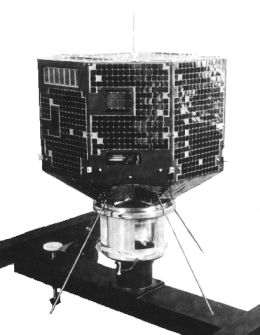Hakucho
Appearance
 | |
| Mission type | X Ray Celestial Observation |
|---|---|
| Operator | Institute of Space and Astronautical Science (Japan) |
| COSPAR ID | 1979-014A |
| SATCAT no. | 11272 |
| Spacecraft properties | |
| Launch mass | 96.0 kilograms (211.6 lb) |
| Dimensions | ⌀760mm×650mm |
| Start of mission | |
| Launch date | 21 February 1979 UTC |
| Rocket | M-3C-Rocket (mission 4) |
| Launch site | Uchinoura Space Center, Kagoshima Prefecture, Japan |
| End of mission | |
| Decay date | April 15, 1985 |
Hakucho (also known as CORSA-b before launch; CORSA stands for Cosmic Radiation Satellite) was Japan's first X-ray astronomy satellite, developed by the Institute of Space and Aeronautical Science (then a division of the University of Tokyo). It was launched from the Kagoshima Space Center by the ISAS M-3C rocket on the M-3C-4 mission on February 21, 1979 [1] and reentered the atmosphere on April 15, 1985.[2]
It was a replacement for the CORSA satellite which failed to launch due to rocket failure on February 4, 1976.[3]
Highlights
- Discovery of soft X-ray transient Cen X-4 and Aql X-1
- Discovery of many burst sources
- Long-term monitoring of X-ray pulsar (e.g. Vela X-1)
- Discovery of 2 Hz variability in the Rapid Burster later named Quasi Period Oscillation.
See also
References
- ^ "Hakucho", JAKA Institute of Space and Astronautical Science
- ^ "CelesTrak: Search Satellite Catalog". celestrak.com. Retrieved Nov 28, 2020.
- ^ "Corsa A, B (Hakucho)". Gunter's Space Page. Retrieved Nov 28, 2020.
